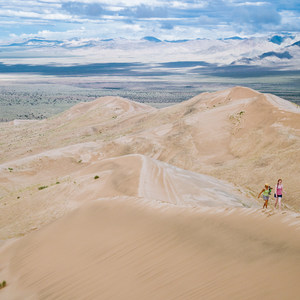You are here
The Desert Studies Center is a Mojave Desert location offering short-term classes for students that is currently managed by the California State University system. It is located in the incorporated community of Zzyzx, California, and small area centered around a the Zzyzx Spring at the northwestern edge of the Mojave National Preserve.
However, the history of the Desert Studies Center provides an interesting read, and it makes the site one of interest to drivers passing by this sparsely-populated stretch of Interstate 15, as the grounds remain partially open to the public between sunrise and sunset daily.
The land, once an army outpost and later a stop along the Tonopah and Tidewater Railroad line, saw its largest development and popularization after radio evangelist Curtis Howe Springer, who had a history of fraudulent claims regarding his own background in medicine, filed a mining claim for the land in 1944. Several previous attempts by Howe to start health resorts had closed or been repossessed. Howe named his Mojave land Zzyzx, boasting that it was "The Last Word" in health. It's more likely that this name was based on the idea that federal mining claims in the area had a relatively small and overworked number of inspectors who went down their location list alphabetically.
Howe, called the "King of Quacks" by the American Medical Association because he may have had no medical educational background at all, developed the land into the Zzyzx Mineral Resort. The resort contained a church, hotel rooms, and lots where homes could be built and which he advertised on his internationally syndicated radio show. Howe had advertised the "natural hot springs" at the resort, despite using a boiler to heat the property's natural spring water before it entered the tubs.
Eventually the federal government sued Howe for operating a private establishment on mining land. In 1974, Howe was forced to forfeit the land, and those who had built homes at the resort were evicted. Two years later, the land was turned over to the University of California system for management.
Today, visiting the grounds is possible during daylight hours. The former resort lies about 5 miles south of Interstate 15. Visitors are asked to park in a gravel parking area just outside of the grounds and walk in. It is possible to see Lake Tuendae, some of the only habitat of the endangered Mohave tui chub, along with the former railroad bed, residential lots, and a mix of buildings, some abandoned and some currently used by the Desert Studies Center. Please be aware and respectful of areas that are signed as off limits to non-students.
Though it may only serve as a quick rest area for those driving the interstate today, it is definitely an interesting piece of strange Americana and worth a visit for those who enjoy these locations.
The visitors parking area has vault toilets, interpretive signs and picnic benches. The nearest amenities are located about 8 miles away in the town of Baker, California.







Comments
Sign In and share them.